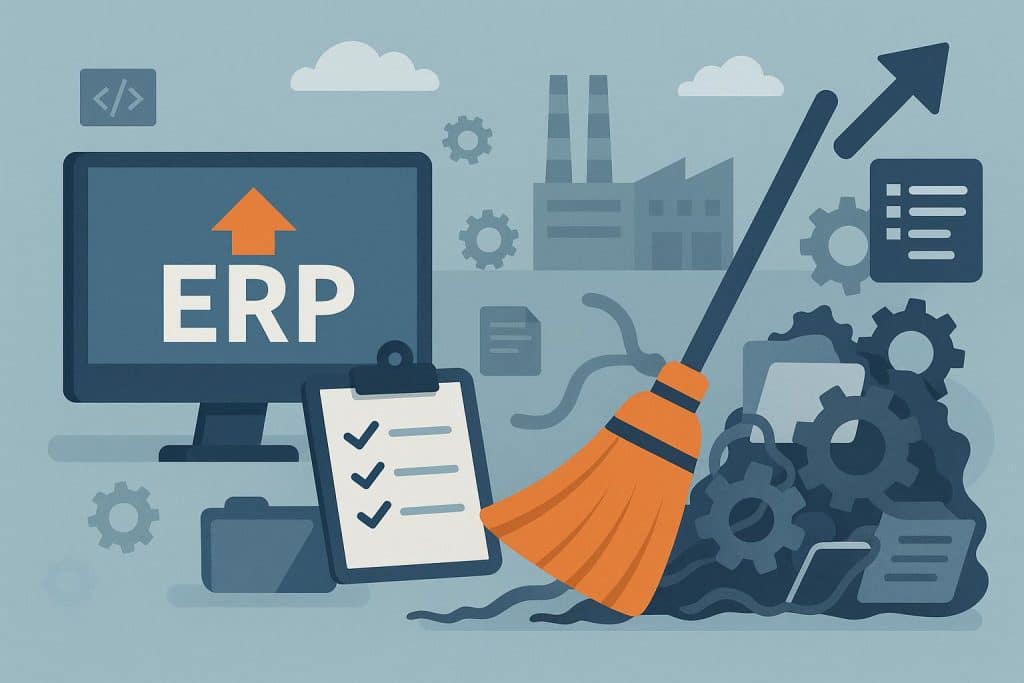A service cart rattles down a plant aisle loaded with mismarked spares and duplicate tags. ERP upgrades roll out across manufacturing and facilities, but MRO data often arrives incomplete, misclassified, or filled with retired parts. When that information feeds a new system, every error multiplies and users lose trust quickly.
Before migration, cleaning item masters and standardizing descriptions cuts wrong shipments, emergency buys, and downtime. Map each field to the ERP target, verify supplier and manufacturer identifiers, and rank high-use spares by spend and fit. Involving maintenance and procurement confirms what’s used in the field. Assign data owners and schedule quarterly checks so the system starts with one verified catalog that supports dependable transactions.
Dirty Data, Broken Systems
Standardized MRO data makes ERP upgrades behave predictably because the system repeats whatever it receives. Inconsistent, outdated, or poorly classified records cause large-scale duplication of errors and create procurement delays and maintenance issues. Start with a structured material master audit focused on duplicates, missing specifications, and nonstandard naming. Include MRO data cleansing as part of this audit to remove inactive part numbers tied to retired equipment, discontinued products, and obsolete suppliers, reducing search time and cleanup effort before migration.
Rebuild item descriptions using one taxonomy that matches the ERP data model, and apply consistent formatting for reliable lookups. Validate supplier and manufacturer identifiers through clear rules and stakeholder sign-off to prevent sourcing, pricing, and conversion mistakes once transactions begin.
Configuration Without Accuracy
Verified part attributes let ERP configuration perform as intended because incomplete or unreliable fields cause modules, workflows, and reports to deliver wrong results. Develop a detailed data-mapping document linking every ERP field to its verified attribute in the source system. Fill essential details such as unit of measure, stocking type, lead time, and priority classification before migration to keep planning logic consistent.
Run pre-launch transaction tests with a representative set of cleaned records to confirm data precision and catch mapping errors. Include maintenance and procurement staff during validation so each field matches real operating practices, not just IT setup. Document decisions and mapping changes in a shared log to simplify any adjustments after go-live.
Downtime And Cost Impact
Unverified MRO records cause downtime and raise costs across operations. Wrong material IDs or mismatched specifications lead to incorrect orders, unusable parts, and expensive rework that damages confidence in the new ERP. Rank materials by spend and usage, focusing verification on those with the biggest operational impact. Cross-check key spares against active asset lists to confirm fit, current part numbers, and supplier availability.
Track emergency and manual purchase orders during migration to expose repeat data issues and document root causes. Measure downtime linked to unavailable or misclassified items to calculate lost production and replacement costs. Use those findings to direct cleanup priorities and present clear ROI results to leadership and stakeholders.
Integration Breakpoints
Integration points between ERP, EAM, CMMS, and procurement systems control how part records move between platforms. When identifiers differ or attributes are left blank, transfers fail and manual reconciliation replaces automation. Build a single standardized MRO catalog that all connected systems read, aligning item IDs, supplier codes, and manufacturer references before migration.
Add an automated validation step to flag mismatched fields or missing attributes during data exchange, blocking bad entries and logging issues for quick correction. Document every integration dependency so IT and operations coordinate version control, catalog updates, and change tracking. Maintain a shared catalog lifecycle to reduce failed transactions and keep reporting consistent across systems.
Making The Upgrade Stick
Lasting ERP improvements depend on maintaining the same data discipline used during migration. Verified MRO records strengthen forecasting, cut unnecessary purchases, and keep maintenance, procurement, and inventory teams working from a single source. Assign permanent data owners in each department with authority to approve changes, correct entries, and manage deletions.
Schedule quarterly data reviews to confirm attributes, refresh classifications, and remove new duplicates before they spread. Connect supplier data feeds so pricing and specifications update automatically, reducing manual edits and mismatches. Track error rates, order accuracy, and part availability, then publish results for accountability and performance tracking across sites.
Effective ERP upgrades depend on verified MRO data owned by operations and procurement. Cleaning material masters before migration prevents conversion errors, wrong orders, and unreliable reports. A structured data review plan should target high-spend spares, confirm supplier and manufacturer identifiers, and remove retired parts tied to inactive assets. Consistent validation during migration keeps records aligned with equipment in use. Permanent ownership, quarterly checks, and supplier-linked updates keep records current long after cutover. Tracking downtime, purchase errors, and holding costs provides visible ROI and proves the value of the cleanup work. Start now by assigning data owners, validating key attributes, and scheduling the first audit this quarter.
